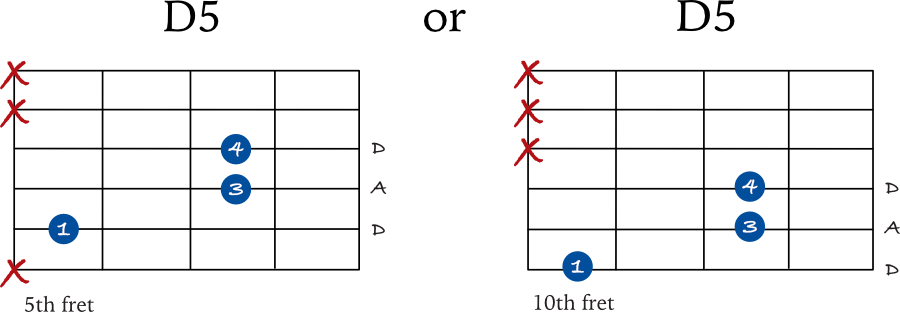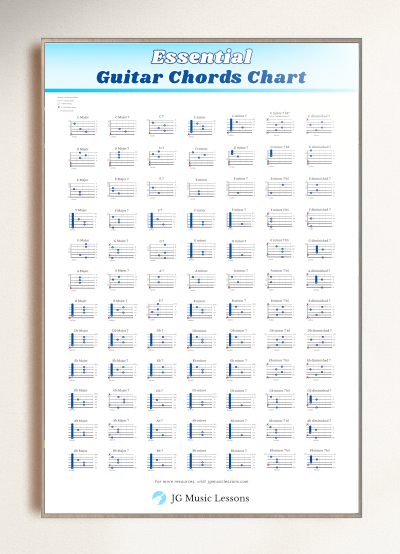Power chords are a simple but powerful guitar technique that is used in a wide range of musical genres, from rock to pop. With this easy-to-follow guide, you’ll learn how to play power chords in minutes, even if you’re a complete beginner.
To get started, here are some key points to know about power chords:
- Power chords allow you to easily play progressions in different keys.
- Power chords can be used as substitutes for barre chords which are harder to play.
What is a power chord?
A power chord is a simplified chord that contains two or three notes, usually a doubled root note and a perfect 5th interval in relation to the root. Power chords are notated with a 5 next to the chord such as C5, D5, G5, or F5. Unlike most chords, power chords don’t include a Major or minor 3rd chord tone.
They are called power chords because they have a gritty and heavy quality that comes from playing them on the lower strings of the guitar. These chord pack a punch even though you only use 2 or 3 notes in a chord. Power chords work great on both electric and acoustic guitars.
Now, let’s look at how to play power chord shapes in the following section and then explore some ways you can apply them to different musical situations.
How to read the chord charts
For the charts below:
- The top horizontal line of the chord chart represents the high E string and the bottom horizontal line represents the low E string.
- The vertical lines separate each fret.
- The numbers in the blue dots tell you which fingers to use on the fretting hand.
- The letters on the right of the charts tell you what notes you are playing on each string.
- Circles on the left represent open strings.
- Red X means to avoid that string.
You can check this link for more on how to read guitar notation symbols.
Open power chord shapes on guitar
The open power chord shape starting on the 5th string is an A power chord, written as A5. The open power chord shape starting on the 6th string is an E power chord, written as E5.
Once you learn the power chord shape on the guitar, we’ll look at how to shift the same shape to other chords by finding the root note (the defining note of a chord or scale).
A power chord or A5 – open 5th string shape

E power chord or E5 – open 6th string shape

The octave root note above is optional but I like to include it for a fuller sound.
Movable power chord shapes
Based on the open chord shapes, here are the movable power chord shapes starting on the 5th and 6th string:

Again, the octave notes played with the pinky finger (4) are optional for these power chord shapes but I like to include it for a fuller sound.
Power chord chart examples
In the following chord examples, you’ll see the same shapes for every chord which include the root note, 5th, and repeated root note above. I’ll include both 5th and 6th string variations that you can try.
C5 – C power chord

D5 – D power chord

F5 – F power chord

G5 – G power chord


Using power chords in a chord progression
Try playing the following chord progression using power chords below. You can play any rhythm you like or try one of these easy guitar strumming patterns.

As you become more comfortable changing between chords, you can also try the progression with different time signatures.
Using power chords to shift key signatures
We can also play the previous progression in different key signatures by shifting the chords. For example, we can shift keys a half step up by moving each chord one fret to the right.

Once you get these power chord shapes down, it becomes really simple to shift the shapes to different starting points, allowing you to use them in any area of the guitar.
It’s helpful to know the notes on the fretboard well so you can easily find the right root notes for your power chords.
12 bar rock blues progression using power chords
Now, let’s put those new power chords in a commonly played progression also referred to as a 12 bar blues. We are keeping things pretty simple for now by using any easy strumming pattern. This will help you to practice transitioning between chords in time without stopping your strumming.
You can use this simple strumming pattern for the progression below.

12 bar rock blues chord progression
Here below is the chord progression you can try with the power chords we’ve covered so far.

Remember that you can play this 12 bar blues on different starting points as long you move every chord the same distance either up or down from the original chords.
Using power chords as chord substitutes
In this section, I’ll give you two examples of chord progressions that includes a barre chord and how you could use a power chord as a substitute.
Ideally, you will eventually want to learn the barre chords in examples 1a and 2a but the second variations (1b and 2b) will show you how to substitute these chords until you get better at barre chords.
Chord progression – 1a

Substituting barre chords – 1b
Using the previous chord progression, this example substitutes the barre chord in measure 2 with a power chord.

Progression 2a
Here is another chord progression example including a barre chord in measure 2. Example 2b will show you how to substitute this barre chord with a power chord.

Substituting a barre chord – 2b

If you don’t already know some of these chords, I suggest going over this other lesson to master the basic chords on guitar.
Wrapping up
Let’s recap some key points about power chords:
- Power chords are simple shapes you can quick apply to your playing. Once you get the shape down, it’s very convenient to shift to other root notes starting on the 6th and 5th string.
- For practice, try experimenting with chord progressions using power chords and then also work on shifting them to different keys.
- Finally, since these chords don’t have a Major or minor 3rd that define a chord structure, they can be substituted for chords with more complex shapes such as barre chords.
📘 Get the free guitar practice guide here!
All the best,
JG Music Lessons
Start Playing Better, Faster
with Pro Membership! ✨
Get the guidance, tools, and support that keep your progress on track:
🏁 Always know what to practice next. Access the full Guitar Learning Roadmap with lessons in sequence.
🎼 Play songs with confidence. Step-by-step lessons of popular, classical pieces and other styles.
📙 Save time and frustration. Clear PDFs and ebooks that save time so you can focus on playing.
🎟️ Get rewarded for consistency. 2 free downloads every month (a $240+ yearly value).
🎁 Keep costs low while you grow. 50% off all charts, tracks, and posters — up to 75% off bundles.
🚫 Stay focused. Ad-free environment keeps you in the zone.
💬 Get help when you need it. Direct member support to keep you on track.

